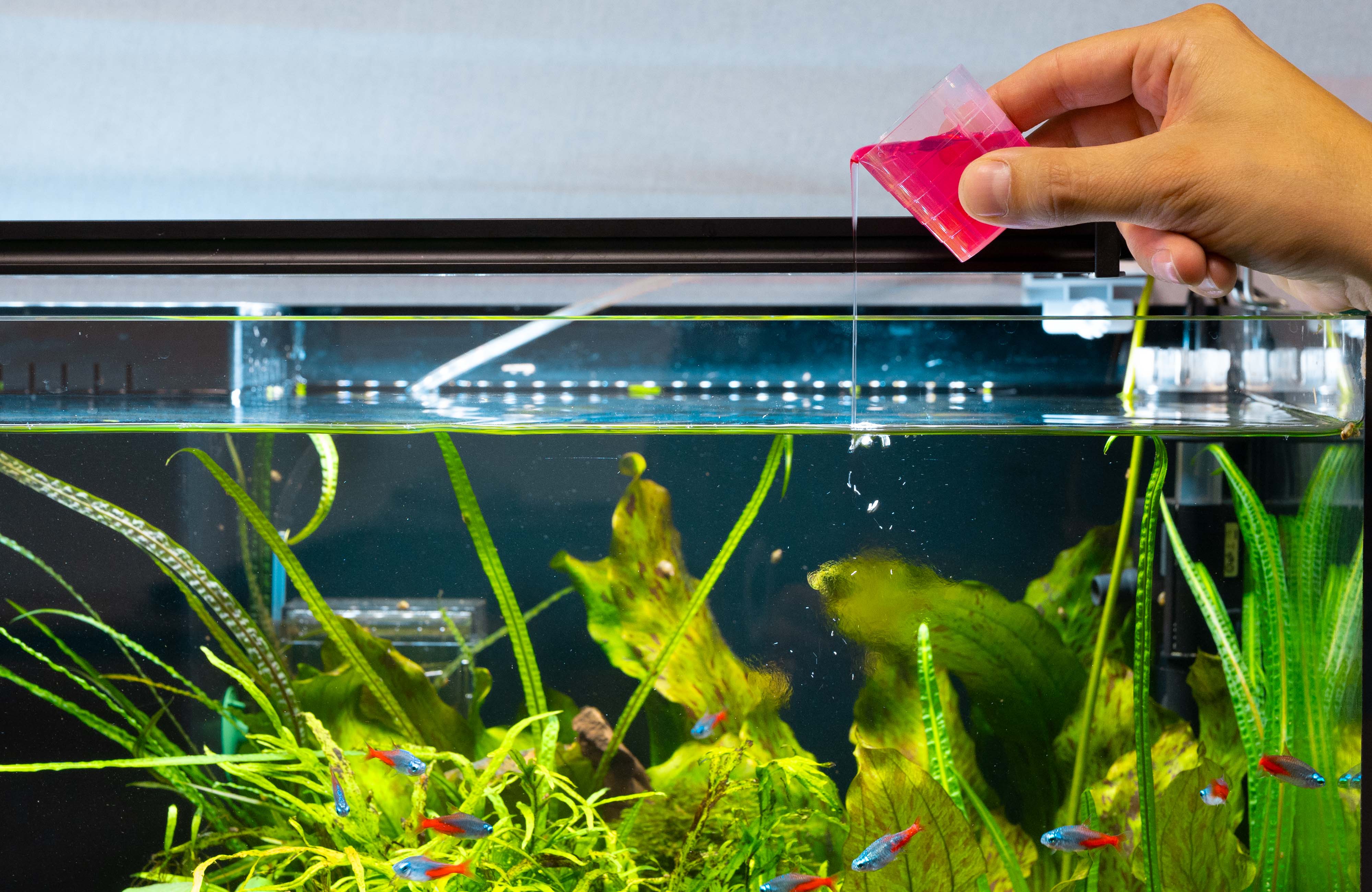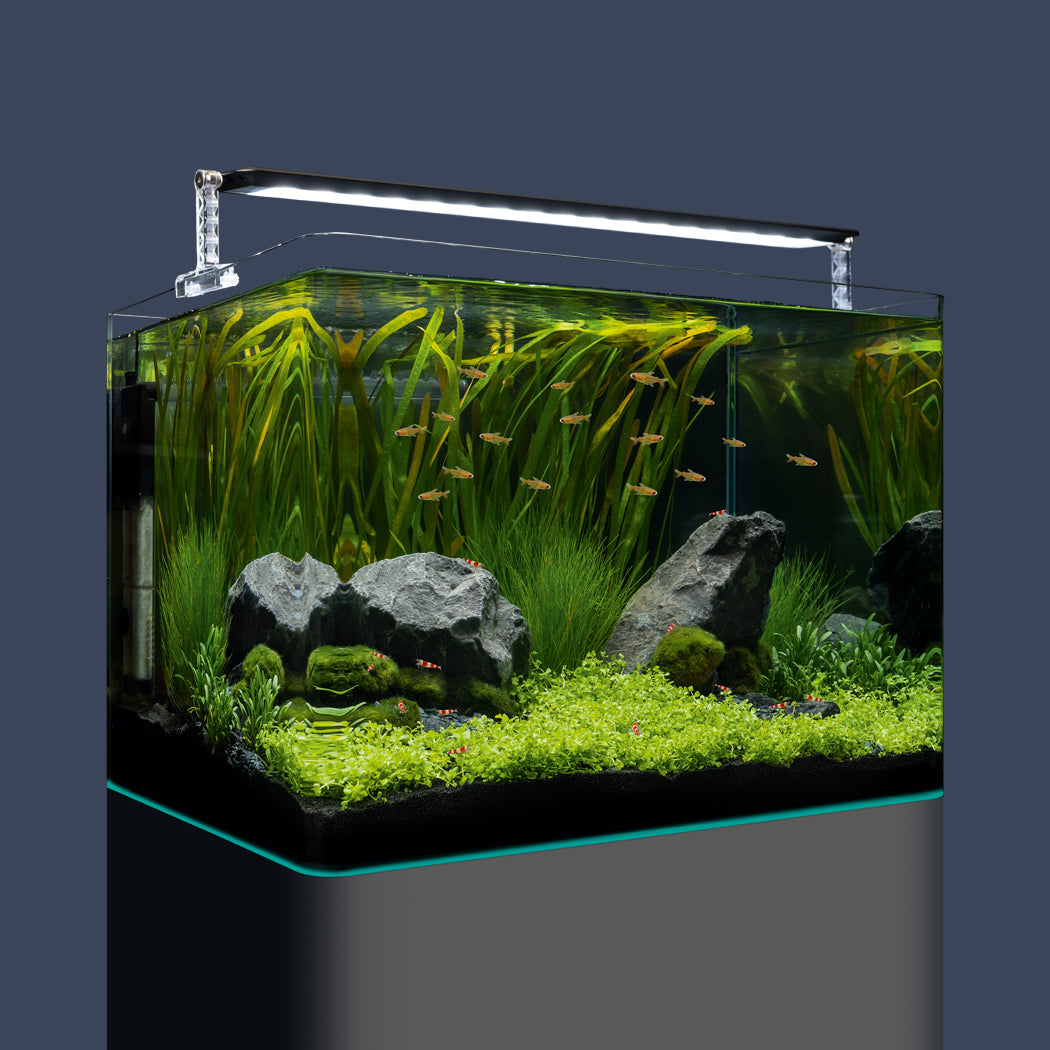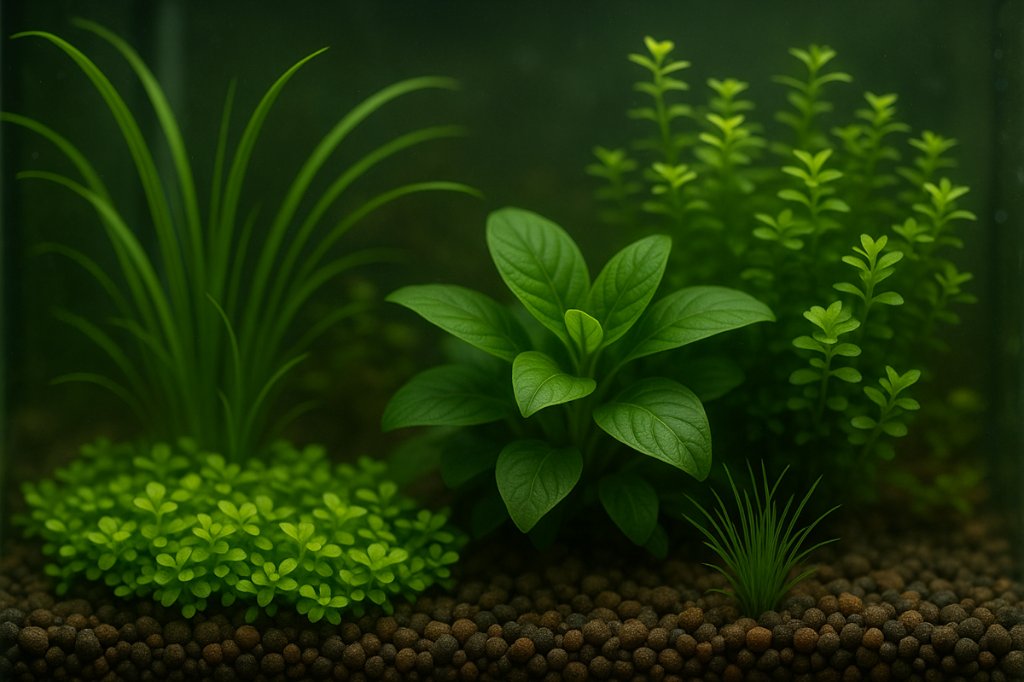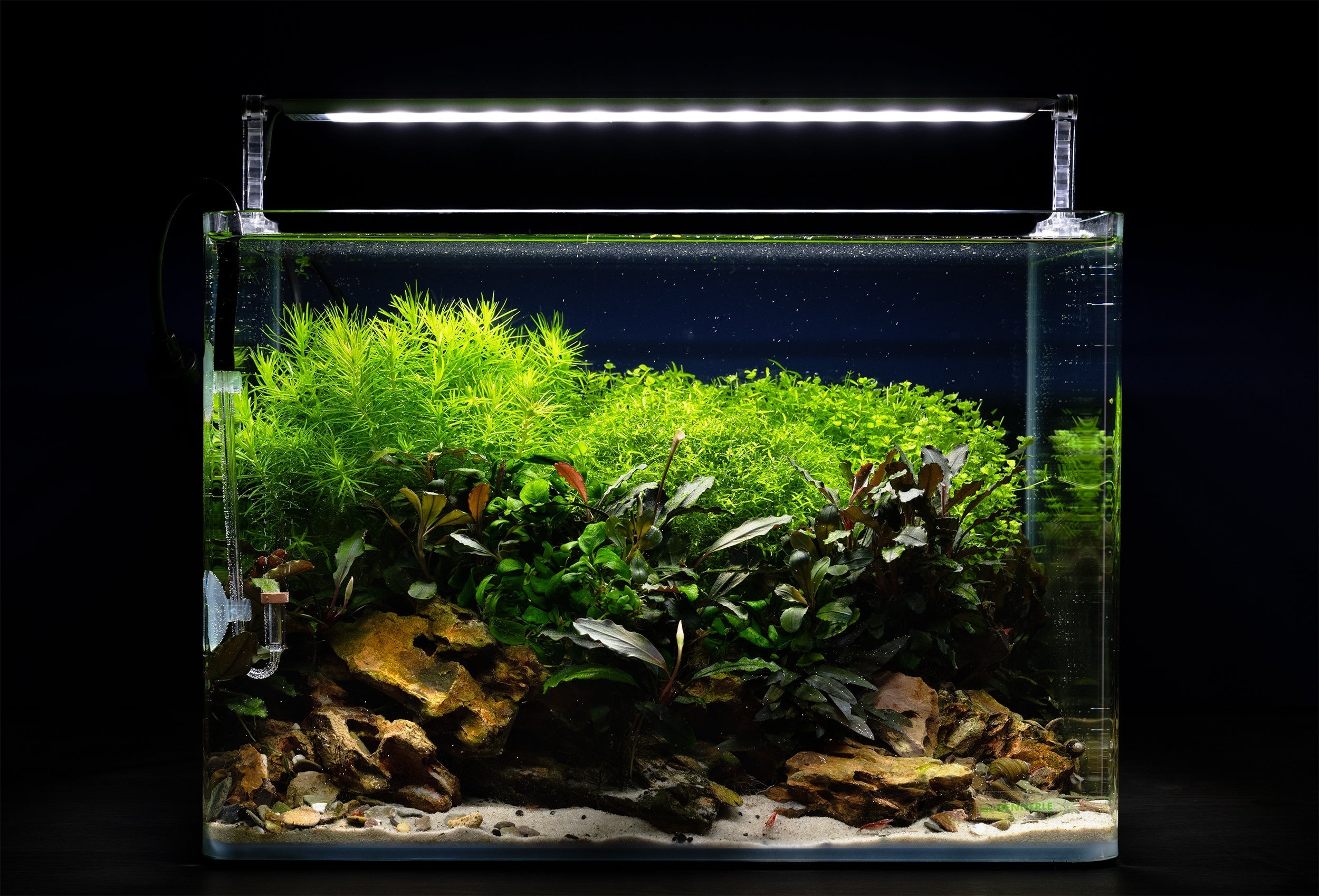Plants always absorb nutrients via roots and leaves. Species with a strong root system prefer the roots, those with fewer roots but a large leaf surface prefer the leaves. For healthy, magnificent growth, the plants must therefore be supplied in both ways.
Nutrient uptake via roots: the substrate
Aquarium plants absolutely need a nutrient substrate as a bottom layer in the aquarium. It provides the foundation for magnificent plant growth. Most aquarium plants are originally swamp plants and like to absorb nutrients through their roots. Gravel alone is not enough because it doesn't contain any nutrients. The correct substrate structure is one of the key factors for a functioning aquarium.
There are two options:
Option 1: Deponit Mix substrate + aquarium gravel 1 – 2 mm
Deponit Mix is a long-term mineral nutrient substrate. It supplies aquarium plants with vital nutrients via the roots. Thanks to its nutrient buffer function, it can absorb excess nutrients present in the water and release them again as required. Another advantage is its long-term effect. Deponit Mix can be used for up to 8 years, often even longer.
Deponit Mix Pro is ideal to combine with light or brown gravel, Deponit Mix Pro Black was specially developed for black gravel.
The substrate is covered with aquarium gravel. Gravel is available in many different colors. Tip: Fish feel more comfortable on darker gravel and show more beautiful colors.
The gravel grain size is also important: 1 – 2 mm is ideal for larger aquaria, 0.7 – 1.2 mm for nano aquaria. This ensures that there is always a certain exchange of substances between the water and the bottom. Gravel or sand that is too fine, on the other hand, hinders the exchange of substances. If the gravel is too coarse, too much food residue disappears between the grains and unnecessarily pollutes the water. This can lead to putrefaction processes in the soil and the formation of harmful putrefactive gases.
Option 2: Soil
Soil is a so-called active substrate, i.e. it influences the water values. Soil reduces the water hardness and therefore makes the water softer and at the same time lowers the pH value (acidity). Many tropical fish, shrimps and plants are used to such conditions from their native habitats and like them. At the same time, soil supplies the plants with nutrients. It is particularly popular with aquascapers.
Please note: Soil wears out like a battery. It should be replaced every 1 – 2 years. It is also not suitable for bottom-dwelling fish such as armored catfish, as they constantly stir up the substrate, which leads to cloudy water.
Tip: An older substrate with a reduced nutrient content can be easily “recharged”. To do this, place an appropriate number of Plant Care Basic Root nutrient balls or Plant Care Pro Root fertilizer tabs in the root area of the plants approx. every 6 – 12 months.
Nutrient uptake via the leaves: liquid fertilizer
All aquarium plants can also absorb nutrients directly through their leaves, the larger the leaf surface, the more. Fast-growing stem plants in particular draw large amounts of nutrients from the water. Regular replenishment of the nutrients consumed is essential if the plants are to grow healthily and vigorously.
As different as aquaria are, so different are the requirements for the appropriate nutrient supply. Ludwig Dennerle was a pioneer in the field of aquatic plants and fertilization. He developed one of the first professional aquarium plant fertilizers back in the 1970s. Today, with over 55 years of experience in the cultivation of aquarium plants and planted aquaria, Dennerle offers the right fertilizer for every aquarium.
Plant Elixir Basic: For all planted aquaria
Plant Elixir Basic offers a universal nutrient supply for all planted aquaria. Figuratively speaking, it is the all-rounder among aquarium plant fertilizers. Plant Elixir Basic is ideal for all normal, planted community aquaria, especially starter aquaria and children's aquaria. Typical for these aquaria is a planting of approx. 50% of the bottom area with various plant species, including some fast-growing stem plants.
Alternatively, you can also use All-in-One Elixir. In addition to the plant nutrients, it also contains carbon, vitamins and other nutrients for fish and shrimps. All-in-One Elixir is particularly suitable as a universal all-round supply and simple aquarium care for beginner aquaria.
Plant System S7 – E15 – V30: For large, heavily planted aquaria
Ludwig Dennerle began cultivating aquatic plants more than 55 years ago. Many customers asked about the correct nutrient supply for plants in their home aquarium. This was the birth of the Dennerle fertilizer system. Since then it has been continuously developed and is now one of the best aquatic plant fertilizers in the world.
The Plant System was specially developed for heavily planted community aquaria. This type of aquarium is characterized by a planting of approx. 70 – 80 % of the bottom area, of which approx. half are fast-growing species and good growing conditions (good lighting, CO2 supply).
The Plant System consists of 3 components that guarantee an even and complete supply of nutrients:
- Plant System S7 vital substances: dosing once a week
- Plant System E15 iron fertilizer: dosing once a month
- Plant System V30 complete fertilizer: dosing once a month
All fertilizer components are highly concentrated and very efficient. The fertilizer system is therefore particularly suitable for large aquaria from 100 liters upwards.
Plant Care Pro: For heavily planted aquaria
A high-performance fertilizer for all heavily planted aquaria with good to very good growth conditions (lots of light, CO2 addition). Plant Care Pro is aimed at aquarists with high demands on plant growth and the overall appearance of the tank. Typically, approx. 70 – 80% of the bottom area is planted with plants, at least half of which are fast-growing species.
Plant Care Pro allows even demanding plant species to thrive. It is therefore ideal for aquascaping aquaria, Dutch aquaria and demanding, well-planted community aquaria.
Plant Care Pro Daily: Daily fertilizer for heavily planted aquaria
In principle, an aquarium fertilizer can be added daily or at longer intervals as so-called shock fertilization, e.g. weekly. With shock fertilization, the plant nutrients are dosed in advance; with daily fertilization, only as many nutrients are added as the plants consume per day.
With weekly fertilizers, such as Plant Care Pro, the nutrients are protected by so-called chelates. These are protective coatings that prevent the nutrients from being oxidized or reacting with other substances in the water and becoming ineffective.
In the Plant Care Pro Daily fertilizer, the nutrients are not chelated or are chelated to a much lesser extent. The advantage: the plant can absorb them even faster and better. However, the nutrients are not stable in the aquarium for as long as with a weekly fertilizer. However, this principle-related disadvantage is more than compensated for by the daily addition of fresh nutrients.
So which is better: daily fertilization or weekly fertilization? In principle, both types of fertilization work. Daily fertilization corresponds more to the conditions in the wild. Here, the plants are only supplied with small amounts of nutrients every day, but this is done continuously, e.g. through nutrient seepage sources. Some aquaria respond better to daily fertilization and some respond better to weekly fertilization. It is best to try both.
Plant Care Pro Daily is also particularly suitable for nano aquaria, as the fertilizer can be dosed very precisely thanks to the practical dropper bottle (2 drops/10 L/day). Possible adverse overdosing is therefore ruled out.
Plant Care NPK: Macro nutrient fertilizer for aquaria without or with a low fish population
The three macro nutrients N = nitrogen (nitrate), P = phosphorus (phosphate) and K = potassium are of particular importance. The addition of N and P is not usually necessary in normal, planted community aquaria, as these substances enter the aquarium in sufficient or sometimes even excessive quantities via the food and fish excrement.
However, the situation is different for sophisticated planted aquaria or aquascaping aquaria. They have an above-average nutrient requirement, especially for macro nutrients. An N or P deficiency can quickly occur in these types of aquarium, especially with no or low fish stocking.
A K deficiency is also possible, but less common, as potassium is always present in the tap water in certain quantities and is regularly added via complete iron fertilizers such as Plant Care Pro.
For demanding plant aquaria, it is therefore very sensible to keep an eye on the macro nutrients and supplement them if necessary.
The biological balance of nutrients is particularly important with an NPK fertilizer. The nutrient ratios in Plant Care NPK have been selected so that all three macro nutrients are absorbed by the plants in equal proportions. This means that even long-term, regular use cannot lead to deficiencies or detrimental accumulations of individual nutrients. This is because nutrient imbalances should always be avoided, as they usually lead to algae problems.
Each aquarium has a specific nutrient consumption depending on the amount of plants, plant species, animal population, feeding, water changes and growth conditions (amount of light/lighting time, CO2 addition, filter technology, etc.). The required addition of NPK should therefore be determined individually for each aquarium.
Plant Care NPK is only used when necessary, i.e. in the event of a genuine macro nutrient deficiency. We recommend measuring the nitrate and/or phosphate content weekly and dosing Plant Care NPK accordingly.
You can also measure the potassium content of the aquarium water. However, this measurement is not usually necessary as the tap water plus Plant Care Pro and Plant Care NPK provide sufficient potassium. An overdose of potassium is hardly possible in practice and is generally not detrimental. Significant overdoses of nitrate and phosphate, on the other hand, can promote algae growth. Plant Care NPK should therefore not be used at the beginning without first measuring the nitrate and ideally also the phosphate content.
If the tap water used for the water change does not contain unusually high levels of nitrate or phosphate, the measurement of the nitrate content alone will later be sufficient in practice as a basis for deciding on NPK fertilization and dosage. Simple immersion tests can also be used for this purpose, e.g. the Dennerle WaterTest 6in1.
If you have been measuring and fertilizing regularly for several weeks, you can see the level at which the measured values settle and which macro nutrient additions the aquarium requires. You can then add the determined weekly dose of Plant Care NPK as standard and increase the measuring intervals to 2 to 4 weeks with a clear conscience.
A good guideline is 10 ml/100 L/week, which corresponds to an addition of 5 mg/L nitrate, 0.4 mg/L phosphate and 2.5 mg/L potassium.
If the tap water used for water changes contains unusually high levels of nitrate (e.g. 50 mg/L) but hardly any phosphate or high levels of phosphate (> 1 mg/L) but hardly any nitrate, then the use of Plant Care NPK is not recommended in order to avoid detrimentally high levels of individual macro nutrients and nutrient imbalances. In this case, Dennerle Plant Care N or Plant Care P single nutrient fertilizers should be used to specifically compensate for nutrient gaps. In addition to the absolute nutrient concentration, the nutrient ratios are also important. Ideally, the nitrate-phosphate ratio should be in the range of 10:1 to 15:1.
If the tap water only contains small amounts of potassium (e.g. < 3 mg/L), Dennerle Plant Care K should be used. This is often the case with very soft water. The analysis values of your own tap water can be obtained from your local water supplier. They can easily be called up on the Internet.
Potassium is also one of the few nutrients that only enters the aquarium in trace amounts through the fish food.
A macro nutrient fertilizer must always be used in combination with a micro nutrient fertilizer. For a complete nutrient supply and the best possible plant growth, we recommend combining Plant Care NPK with Plant Care Pro.
Macro nutrients, guide values for plant aquaria
Ideal values mg/L
Nitrate = 10 – 15
Phosphate = 0.1 – 0.3
Potassium = 10 – 15
Recommended concentration range mg/L
Nitrate = 5 – 30
Phosphate = 0.01 – 0.1
Potassium = 5 – 30
Plant Active Enzymes
One would assume that a plant grows at its maximum when a sufficient amount of light, CO2 and nutrients are available. But this is not the case. Practice shows that there are other factors that have a beneficial effect on growth. Dennerle carried out extensive research into these secondary growth factors at an early stage. This resulted in Plant Active Enzymes.
Plant Active Enzymes has multiple effects. Growth-stimulating, natural plant enzymes stimulate cell division. Enzymes are bio-catalysts and are of central importance for plant metabolism. For example, they convert reserve substances into soluble substances that the plant uses for growth. This promotes the formation of new leaves and shoot growth. Aquascapers therefore like to use Plant Active Enzymes after pruning to accelerate new growth.
At the same time, selected natural active ingredients support the building and energy metabolism. They can be absorbed and metabolized by the plant directly via the leaves. This strengthens the plants and can increase their defenses, e.g. against algae growth on the leaves.
Plant Active Enzymes also has a positive effect on the redox balance in the aquarium. Oxidation oxidizes numerous nutrients, rendering them ineffective for plants (e.g. iron, manganese). Reduction converts these nutrients back into a form that plants can absorb. Plant Active Enzymes promotes these reduction reactions. Plant nutrients that have become ineffective are remobilized in the aquarium and thus made available to plants again. The growth environment is optimized.
Particularly positive: By sustainably promoting plant growth, Plant Active Enzymes simultaneously creates unfavorable growth conditions for algae. Existing algae are slowed down and new algae growth is significantly reduced.
What makes Dennerle aquarium plant fertilizers so special?
Dennerle has outstanding know-how and over 55 years of experience in aquarium plant research. All fertilizers are developed in our in-house research and development department and tested in extensive practical trials under controlled laboratory conditions.
Our fertilizers provide aquatic plants with all the essential nutrients and trace elements they need for vigorous, lush growth.
We always pay particular attention to the biological balance of the nutrients. The nutrient ratios are selected in such a way that all trace nutrients are absorbed by the plants in roughly equal proportions. This means that even with long-term, regular use, there can be neither an undersupply nor a detrimental accumulation of individual nutrients.
They work immediately. All nutrients and nutrients are available in a directly absorbable, plant-active form. Valuable trace elements such as iron and manganese ensure lush green leaves and bright colors. Red and red-brown leaf colors are intensified, attractive patterns are enhanced.
Dennerle aquarium fertilizers effectively prevent nutrient deficiencies and prevent yellow, glassy leaves in the long term. They strengthen the plants from the inside out and help with stagnant growth. Highly effective protective coatings (chelates) keep the nutrients available to the plants for a long time. All fertilizer products can be stored for at least 5 years without any loss of quality (no “blackening”, i.e. nutrients becoming ineffective).
And they are 100% safe for fish, shrimps, crabs, snails etc. when dosed and applied correctly.




Share:
Plant care - Part 2 - Plant nutrients
Plant care – Part 4 – Dosage